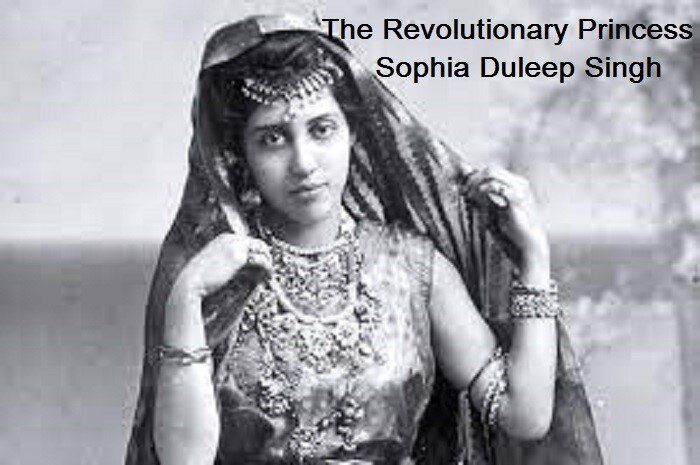Remembering Sophia Duleep Singh: The Princess turned women's rights activist

Sophia Jindan Alexandrovna Duleep Singh was born in 1876 and named after her father, Duleep Singh, the last Maharaja of the Sikh Empire. The British had treacherously forced him to give up his prosperous kingdom, which spanned most modern-day Afghanistan, Pakistan and Northern India. Her grandfather, Maharaja Ranjit Singh, was the last emperor of the Sikh Empire. Her mother was a half-German, half-Abyssinian woman whom her father met in Egypt.
Princess Sophia grew up at Elveden Hall, Suffolk, where her father lived in exile. She was by all accounts a quiet and shy child, hardly a threat to the Establishment. In 1894, she moved to Hampton Court Palace at the invitation of the Queen.
Despite the British having robbed Duleep Singh of his inheritance, he enjoyed a close relationship with Queen Victoria, and she became Sophia's godmother. With the Queen as her godmother, Sophia grew up in England with all royal trappings, and her life seemed destined to be one of ease and comfort.
She was a fashion icon and a well-known socialite in the British royal society in her early years. She was also a keen animal lover, and her other hobbies included photography and music. Then a trip to India in 1903 with her sisters dramatically changed her outlook and worldview. This trip transformed Sophia from a socialite to a royal revolutionary. After leaving a country where she was a celebrity, she arrived where officials held little regard for her. She encountered racism. She saw abject poverty and famine endured by people living under British rule. During this trip, she met Indian freedom fighters and found herself inspired by their cause and thus started her journey as an activist fighting for equality and rights.
Her time in India fostered a strong social conscience, and within her grew an unsatiated desire for a cause. When she returned to England, she wholeheartedly started supporting the suffragette movement alongside other women's rights.
Thus, the nineteenth-century Indian Princess Sophia transformed into a radical royal, a revolutionary, a militant suffragette, and a pivotal figure in the suffrage movement as she campaigned hard for women's rights.
She soon transformed into a known militant suffragette and was regularly seen at protests grappling with police and selling suffragette newspapers outside her apartment at Hampton Court Palace.
Sophia's next protest targeted the Prime Minister, Herbert Asquith. In 1911, on the State Opening of Parliament, Sophia positioned herself outside 10 Downing Street and waited for the Prime Minister to appear. Just as he was due to drive away, she flung herself before his car and thrust a poster on the front window. It read 'Votes for Women'.
Her constant protests enraged the British government, and she was often arrested but freed soon as it was an embarrassment to keep Queen Victoria's goddaughter in prison. Due to her continuous protests against the Establishment, she was side-lined and ignored by the Queen.
Besides playing a leading role in the suffragette movement, Sophia also participated in the Women's Tax Resistance League and the Women's Social and Political Union.
Sophia's social conscience extended far beyond women's rights, and she supported many groups, mainly Indians and Sikhs, wherever she encountered them. Sophia truly dedicated her life to the fight for equality and the support of others.
She formed close ties with the Sikh community in London, regularly visiting the Sikh temple at Shepherds Bush. She frequently attended functions organised by the India Office, including receptions for distinguished Indian visitors.
Sophia supported the Indian Women's Education Association, volunteering at their stall at Claridges in 1921, which the Conservative Women's Reform Movement arranged.
Like her father, Sophia supported the Lascars Club, which helped poor Indian seamen and sailors stranded and left to fend for themselves in London. She also cared for the Sikh and Indian soldiers who came over to Europe for the war and did whatever was possible to support them. She felt a deep emotional connection with people from India. The Princess visited and even nursed troops at Brighton Pavilion and other hospitals for Indian soldiers. As the story goes, the Sikh soldiers could hardly believe that "the granddaughter of the famed Maharaja Ranjit Singh sat by their bedsides tending to their injuries dressed as a nurse.
Princess Sophia died in her sleep on 22 August 1948 in Colehatch House, in Penn, Buckinghamshire, a residence once owned by her sister Catherine, and was cremated on 26 August 1948 at Golders Green Crematorium. On her instructions, she was cremated with Sikh rites, and a full band played Wagner's 'Funeral March' at her cremation. Her ashes were sent to India.
On 15 February 2018, a postage stamp was issued in her memory by the British government. The world is slowly waking up and acknowledging Princess Sophia's contribution, thus giving her a due share in history, as otherwise, she was often referred to as the forgotten Princess.




